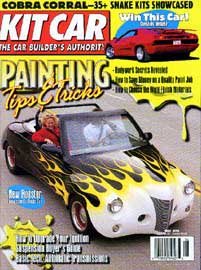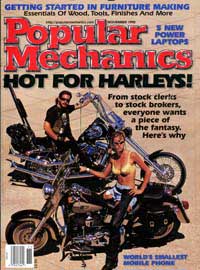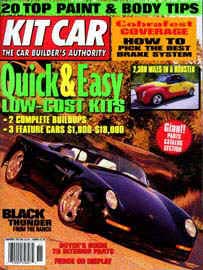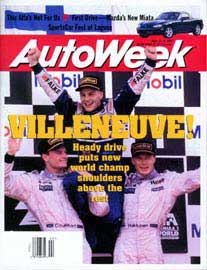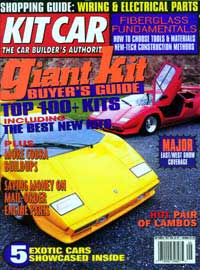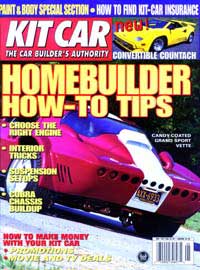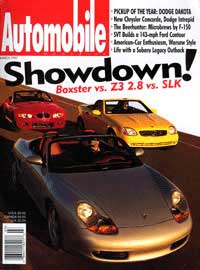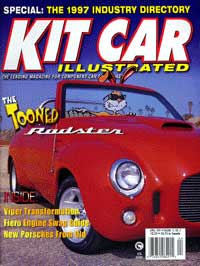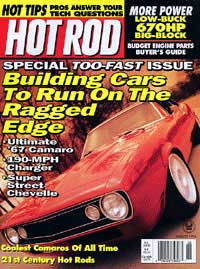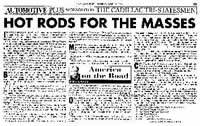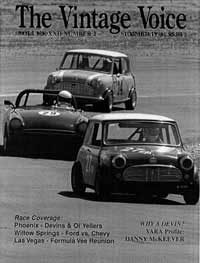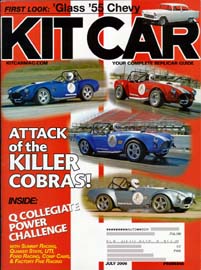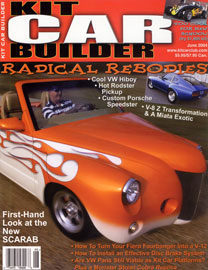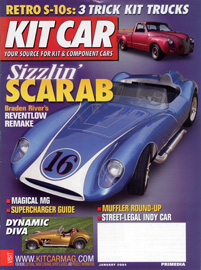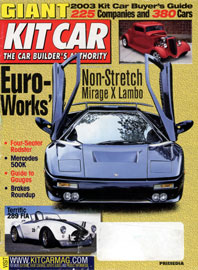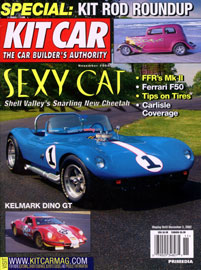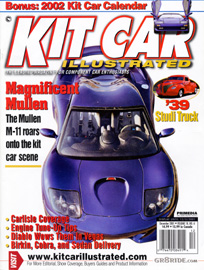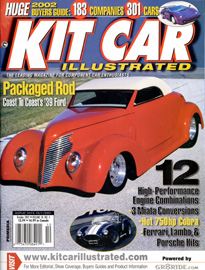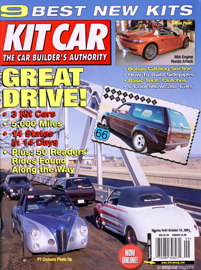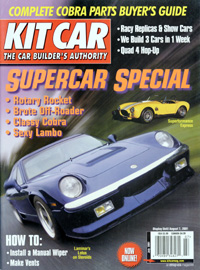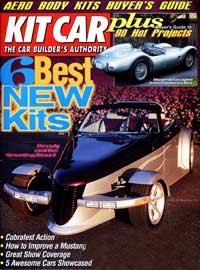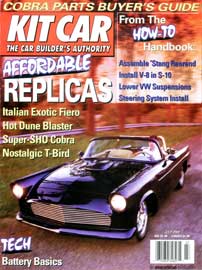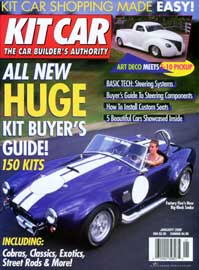What
is the Rodster®?
© Copyright Caroselli.
No images or text located anywhere on this site may be reused
or republished without expressed written permission from Rodster,
Inc., d.b.a.: Caroselli Design. The Rodster Street Rod design
is protected by
U.S. Patent # D450,284.
"Rodster®" is a registered
trademark of Caroselli Design. |
What
is Car and Driver Magazine saying
about the Rodster® Street Rod?
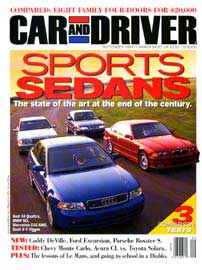 Car
and Driver Magazine
Car
and Driver Magazine
SPECIALTY FILE
Caroselli Rodster
A cool, affordable, back-to-basics, home-built street rod.
by Barry Winfield
Henry Caroselli thinks hot rodding should be more about fun and less about heavy investment in what's becoming an elite hobby. Who can argue with that?
When hot rodding bloomed in the '50s, it was about modifying inexpensive used vehicles of the time, finding ways to make horsepower, and making the cars unique examples of aftermarket art.
Now check out Caroselli's build-it-yourself Rodster. Beneath the fiberglass nose and tail sections lives what was once a traditional three-door Chevy Blazer S10, circa 1983-94. Even the doors have been retained (although with the window frames pruned); their accent lines have been artfully extended into the new plastic bodywork. Lighter rear-wheel-drive donors are preferred (four-wheelers must run front and rear tires of identical size). And obviously, a later-model donor with a 160-to-200-horsepower, 4.3-liter V-6 will result in a more hot-roddy finished product.
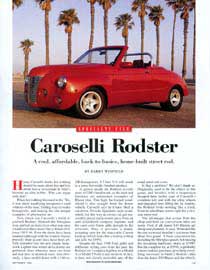
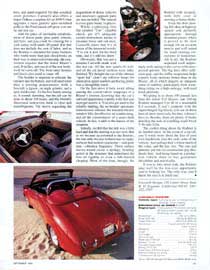
A glance inside the Rodster reveals more of GM's handiwork, as the dash and furniture are untouched examples of Blazer trim. That high, fat-framed windshield is also straight from the donor vehicle. Caroselli says he'd have liked a cut-down, Porsche Speedster-style windshield, but this way an owner can get reasonably priced replacement glass from an auto-windshield company anytime, and the carry-over frame adds strength to the structure. Plus, it provides a handy mounting spot for the removable Carson hardtop (which looks like a folding softop and sells for $595).
Despite the faux 1940 Ford grille and deliberate styling cues from the past, the Rodster isn't a replica highboy or a Model A or Model T Ford in any iteration. In fact, it does not closely resemble any of the usual street-rod icons.
Is that a problem? We don't think so. Originality used to be the object in this game, and besides, with a suspension dropped three inches (part of Caroselli's complete kit) and with the alloy wheels and upgraded tires filling the fat fenders, the Rodster looks nothing like a truck. Even its wheelbase seems right for a two-seat street rod.
The advantages that accrue from this chop-and-bolt-on conversion idea are many. First of all, donor S10 Blazers are cheap and plentiful. A used '89 model like the one we tested shouldn't cost more than about five grand. A basic conversion kit, including the fiberglass panels but missing the mounting hardware, starts at $3995. But the complete kit, at $5995, is probably a more realistic purchase, providing everything necessary to build a Rodster other than the donor S10 Blazer and the wheels, tires, and paint required for that essential stsreet presence. Caroselli also offers a Super Deluxe complete kit (at $6995) that upgrades a more generic open-mouthed grille to the Ford knock-off prow you see on our test car.
Add the price of inevitable refurbishment of donor parts, plus paint, wheels, and tires, and you could be cruising for a cash outlay well under 20 grand. But that does not include the cost of labor, and as the Rodster is intended for home builders who wield more than just checkbooks on the way to street-rod ownership, the conversion requires that the donor Blazer's roof, B-pillars, and much of the rear bodywork will be sawn off. The front outer fenders and fascia also need to come off.
The builder is required to relocate the radiator and the battery and will need more than a passing acquaintance with a Sawzall, a jigsaw, an angle grinder, and a spot-weld cutter. To the less handy among us, it sounds daunting, but the job can be done in about 100 hours, and the liberally illustrated instruction book is clear and unambiguous. Tip sheets regarding acquisition of donor vehicles and necessary upgrade parts are also included. The manual is even quite funny in places.
While explaining that the symbol "2x(double check -- get it?) alongside certain instructions means to measure it twice and cut once. Caroselli jokes that it's in honor of the immortal words: "I've cut it now for the third time, and it's still too short."
Obviously, that was not a mistake Caroselli made with this test car. All the new panels fit well, and all the cut metal sections were tidily finished. We thought the use of the chrome "sport bar" (don't say rollover hoop) for alternative upper seatbelt-anchoring points was a thoughtful touch.
On the first drive it feels weird sitting among the conservative trappings of a Blazer's interior, knowing that the car's outward appearance is pretty wild. But you soon get used to it. You also get used to the reliable starting, the no-brainer automatic transmission selector, the retained electric window lifts, the effective air conditioning, and all the conveniences of a series-built vehicle. In fact, it adds to the humor of the situation.
Intially, we felt that the ride was a little hard and that the steering was too slow. But as we became accustomed to the Rodster, the ride only became bothersome on ripply surfaces that incited a particular -- and quite rare -- vibration frequency. These surface waves would excite a springy, bending action in the structure that underlined the loss of rigidity in even a full-framed choptop. Most of the time, though, the Roster rode securely, with little cowl or steering-column shake.
Even the slow steering felt okay at highway speeds and perfectly appropriate through mountain passes, where it proved to be slow enough for an accurate turn-in and well suited for small steering corrections in midcorner. All in all, the Rodster acquitted itself surprisingly well, taking to the curves with unexpected aplomb. The big tires offer sufficient grip, and the stiffer suspension helps control body motions better than in the Blazer, all of which imparts an adequate sense of stability, particularly from something riding on a high-mileage, well-used truck platform.
Weighing in at about 100 pounds less than the donor S10 Blazer, our 160-hp Rodster managed 0 to 60 in a reasonable 8.3 seconds. It can't compete with the supercharged big-blocks you see in those best-of-show street rods, but then, it doesn't have to. Besides, there are plenty of books detailing the task of installing small-block V-8s into S10s.
The coolest thing about the Rodster is its humble price. In the event of a rip-off, you'd worry more about the loss of your own handiwork than the cash value of the vehicle. And perhaps that's where much of the value, and the fun, lies. The care and patience put into its construction pay dividends later. And being based on a production vehicle more or less guarantees drivability and practicality.
If you're into street rods, the Rodster may well be the low-cost opportunity you're looking for. The only way you'll know for sure is to build one.
Caroselli Design, 128 Center Street, Suite B, El Segundo, California 90245; 310-322-2767
CAROSELLI RODSTER
Vehicle Type: front-engine, rear- or 4-wheel-drive, 2-passenger, 2-door roadster
Estimated price as tested: $15,000*
Engine type: 12-valve pushrod V-6, iron block and heads, GM engine-control system with 1x2-bbl throttle-body fuel injection
Displacement...........................................262 cu. in. 4300 cc
Power (SAE net)..................................160 bhp @ 4000 rpm
Torque (SAE net)................................230 lb-ft @ 2800 rpm
Transmission..........................4-speed automatic with lockup
torque converter
Wheelbase................................................................100.5 in.
Length.......................................................................157.0 in.
Curb weight..............................................................3100 lb.
Zero to 60 mph...........................................................8.3 sec.
Street start 5-60 mph..................................................8.1 sec.
Standing 1/4 mile....................................16.9 sec. @ 80 mph
Top speed (drag limited)..........................................105 mph
Braking, 70-0 mph........................................................227 ft.
Roadholding, 300-ft-dia skidpad..................................0.78 g
EPA fuel economy, city driving...................................17 mpg
C/D-observed fuel economy........................................18 mpg* Donor 1983-1994 Chevrolet S10 Blazer plus #3995-$6995 for kit.
